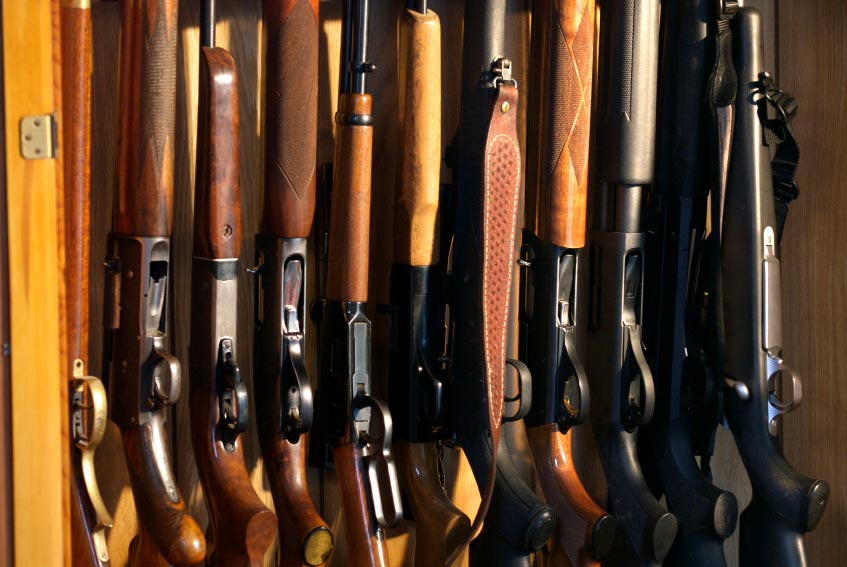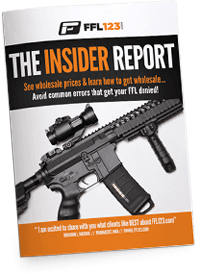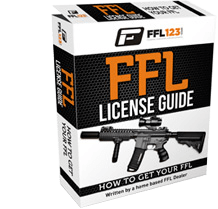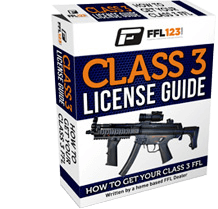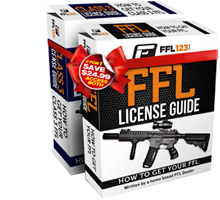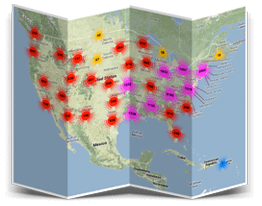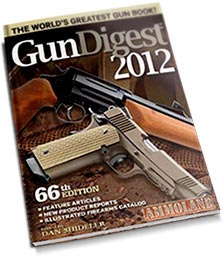A lot of people ask how many firearms are manufactured in the United States each year. That is an excellent question, particularly for those who are looking to get into the gun business with an FFL. Knowing how many guns are manufactured in the United States on an annual basis, along with how many FFL’s and types of FFL’s there are in each state, how many registered NFA items by type and how many new NFA items are made each year all impact your business decisions. Having access to those numbers is an important part of running a successful gun business, and fortunately the ATF publishes them each year, with a small delay to protect manufacturing trade secrets.
The ATF’s Firearms Commerce in the United States Annual Statistical Update (PDF download) gives manufacturing and import data for all the types of firearms imported or made in the United State. There are some limitations to this data which we’ll get to in a moment, but it is an exceedingly valuable tool to study to learn about market trends, industry growth, and what kinds of firearms are selling in the US.
Table of Contents
About Firearms Commerce in the United States
For starters, the ATF’s data is by design a couple of years out of date. This is because releasing up to the minute information could violate the Trade Secrets Act, and to protect manufacturers from having their competition gain access to sensitive manufacturing or import information.
Guns are only broken down by type (e.g., rifle, revolver, shotgun, etc…) not by manufacturer or caliber/gauge, so you really can’t use this data to predict trends in specific types of guns. It also offers a wealth of statistical data such as the number of FFL’s in each state, the number of registered NFA items broken down by type per state, the annual number of FFL applications and their outcome per state, the number and types of applications to make or transfer NFA firearms, and much, much more.

In some cases, data will go back over 40 years, and in all cases, multi-decade data is provided, which makes forecasting and studying trends extremely easy.
You can also use this guide to find out what types of guns are being imported and from where. For instance, it’s not surprising to see a lot of handguns come in from Serbia and Austria, which is where Springfield XD and Glock pistols each come from.
Let’s start digging into the most important parts of this guide and see how they can help you with your FFL or decision to apply for an FFL.
Number of Firearms Manufactured in the United States by Type
If we want to know how many guns are made in the United States each year, this information is give to us right up front. In fact, we can see how many guns have been made each year from 1986 to 2017. Remember, this information is delayed a couple of years for obvious trade secret reasons.
How many guns were made in the United States in 2017, and what types? Well, there were:
- 3,691,010 semi auto pistols
- 720,917 revolvers
- 2,504,092 rifles
- 653,139 shotguns
- 758,634 miscellaneous firearms (frames, pistol grip shotguns, receivers, etc…)
There was a whopping 8,327,792 different guns made in the US in 2017. However, that is down from 11,497,441 in 2016, with semi auto pistols and rifles taking the biggest hits in numbers. In fact, we have to go all the way back to 2012, when folks were still recovering from the Great Recession to find firearms manufacturing as low as 2017.
And not all these guns were sold in the US. In 2017, almost half a million of them were exported out of the country, leaving well over 7 million American made guns in the country to be sold.
What Can We Learn from Manufacturing Data?
As we see, in 2017, there were a lot of guns made in the US, but not as much as in previous years. Why is that, and what does it mean for FFL dealers?
2016 had a huge rise in gun sales because of the highly volatile presidential election. Fears of Hillary Clinton winning drove sales of guns through the roof based on very real fears of new anti-gun legislation on a Federal level. With the GOP holding the White House and Congress, that fear dropped, and with 2017 showed a drop in sales due to extensive buying the year prior. Plus some manufacturers held large amounts of inventory built up against the chance of future gun bans.
With Democrats openly talking forced firearms confiscation as part of their presidential campaigns, and a GOP that has seemed unwilling to stand up for gun rights over the last few years, we can reasonably expect to see a spike in sales through 2020.
More Lessons From Manufacturing Data
While the ATF’s report doesn’t tell us if a pistol sold was a .22 or a 9mm, or a rifle a bolt action or AR-15, we can still infer a lot of useful information for retail purposes from these numbers. By far, the most popular product categories are semi auto pistols and rifles of all types. This isn’t terribly surprising, as concealed carry permit holders tend to increase each year, and a great many states now don’t require a permit to carry a concealed pistol.
Rifle sales include the ever popular AR-15 and AR-10 style semi-auto sporting rifles. But this also covers things like bolt action hunting rifles, target rifles, and other kinds of rifles like .22’s.
Speaking of AR style rifles, notice the numbers for guns that include frames and receivers. Many shooters enjoy building their own custom or semi-custom AR style rifle or pistol buy buying a lower receiver and then assembling the rest of the gun themselves, but that’s something to discuss more in depth later on in this article.
We can look at ATF manufacturing data to broadly tell us what are the most popular kinds of guns being made and sold. Looking at these numbers, it’s safe to say that rifles and semi-auto pistols are your biggest sellers. But we haven’t looked at import data yet, as that can skew some of these figures.

Numbers of Imported Firearms
We saw that 2017 was something of a slump after a year of heavy buying based on political concerns, but how was the import market?
Well, 2017 showed a drop in imports too, but the data for imported guns isn’t delayed like manufacturing information is. That lets us look right now at 2018 vs 2017 import numbers and it shows numbers went up, except for handguns, which dropped slightly from 2017 imports.
In 2018, the following firearms were imported:
- 713,931 shotguns
- 652,031 rifles
- 2,939,889 handguns of all types
Contrast to 2017 with 632,105 shotguns, 572,309 rifles, and 3,287,842 pistols.
Broadly speaking imports represent about half again what is made in the US, or roughly 1 out of every 3 guns in the last year were imports. Imports also include things like military and police surplus imported for the collector markets, along with new production firearms. We should expect a chunk of those imported rifles and pistols to be things like surplus as opposed to new production.
As an FFL holder, the large number of imports and the fact they often carry decent profit margins makes them hard to ignore. Imported entry level shotguns practically dominate the low price shotgun market with various Chines and Turkish imported pump action and tactical shotguns.
Many imported pistols are for big companies like the Springfield XD line, Rock Island, Glock, and Taurus, while many imported rifles are various sporting guns like CZ .22 target rifles or various semi-auto sporting rifles based on foreign military pattern guns like the AK-47 or various FAL style guns.
Miscellaneous Firearms
We saw that a bit over three quarters of a million “miscellaneous” firearms were made in 2017. This is a really interesting statistic for FFL holders, because it includes things like the Mossberg Shockwave (and related shotguns) and AR style lower receivers. Both of these are increasingly popular in the marketplace but for different reasons.
Various birdshead grip shotguns are on the market and offer short barrel shotgun performance without NFA registration. Manufacturers took advantage of the fact that a shotgun that never had a buttstock fitted but has an overall length of at least 26” can be fitted with a short barrel. In states that ban short barrel shotguns, or for customers who don’t want the hassle of buying an NFA item, these little shotguns are popular sellers and a great way to get people into your shop to look.
AR style rifles and pistols are both very popular and very easy to build at home with parts and kits purchased locally or on the internet. While lower receivers don’t have much of a markup, they are in demand, and if you have a good array of AR parts and tools to sell at the same time, you can do a tidy business in this area. Some FFL’s sell lowers basically at their cost in order to attract buyers for other guns or accessories.
Either way, the growth market for people looking for NFA type guns without the paperwork, and home builders of AR and other style guns makes this an interesting market for FFL holders to look into.

NFA Data
If you are a dealer in NFA items or want to get into that market, the ATF’s annual report is full of rich data for you too. The state by state breakdown of types of NFA items registered, number of NFA applications and more gives important market data.
If you are considering selling NFA items, check and see how well they are moving in your state. If there are few transfers and few dealers, it could mean a growth market for you to enter, or it could mean that your state makes owning NFA items very difficult. If your state has lots of NFA transfers and NFA dealers, the market may be too crowded, unless you can serve a particular niche, or local demand.
The markups and fees on transferring NFA times can make it profitable to just move a few each year though, especially if you have a Class 03 SOT to go with a Class 07 manufacturing FFL. You can see from the NFA data section that silencers are a big growth sector, particularly as more and more states allow their ownership and use in hunting.
FFL Statistics
No matter if you have an FFL or are considering getting an FFL, there is plenty of data that helps you understand the gun business in your state.
The ATF breaks down on a state by state basis how many FFL’s there are, what types they are, and even how many people are applying for FFL’s and by what type. They also list how many applicants are denied (but not why), how many FFL’s are surrendered or abandoned (out of business), and what percentage of FFL’s are inspected for compliance issues each year.
What does this mean for you? Well a lot really. For starters, you can see exactly how many FFL’s are in your state. It’s nice to know exactly how many many participants there are in your market. You can look at the different kinds of FFL’s and start figuring out roughly how the market is broken up in your state.
For instance, Texas has almost 11,000 FFL holders. But only 858 are NFA dealers, and 604 are Class 03 manufacturers. Texas is one of the largest markets for NFA guns in the entire country, so you can use those three pieces of information to make decisions on possible business decisions. The same goes for any state, and if you are a manufacturer, you can even make some state level marketing decisions based on information in this report.
Studying the Past to Plan for the Future
There is an old saying that “history doesn’t repeat itself, but it often rhymes”, and FFL holders and applicants can rely heavily on the annual ATF report to see what might be rhyming. It might sound like we are repeating ourselves, but this is important statistical information on nearly all industry levels.
Any good businessman or even historian will tell you that these kinds of primary sources are invaluable for market forecasting, industry analysis and predicting future growth or decline in business. Of course the raw numbers, as fascinating as they are aren’t always enough.
Remember when we talked about the boom in firearms sales in 2016 and their decline in 2017 and the causes for them? And then used that to forecast an increase in 2020? Just looking at ATF provided numbers alone won’t tell us why more guns or less guns were made in the US or imported in a given year. That’s where being tuned in to the broader industry news comes into play.
Now some information winds up hitting the mainstream press. The huge increase and then sudden decrease in sales 2016-17 were fairly well documented in the media. It was a matter of national interest, and political pundits on all sides were using it to make talking head commentary for their pet causes. But those of us in the firearms industry can use that information to make sound business decisions.
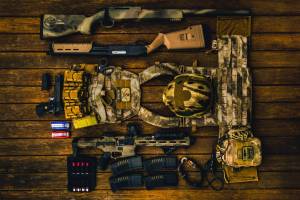
But outside of hoping your favorite TV news channel does a story on gun sales, how else do you get industry information to supplement ATF manufacturing data? Well, if you are an FFL123 customer, we take care of you even after you get your FFL.
FFL123 offers all their customers access to unique industry insider information. Our staff have many decades of combined experience in the firearms industry from manufacturing to research, and through our industry contacts, we keep our customers up to date on important news through our newsletters, website and member only web forums.
Of course you’ll probably want to join organizations of interest to your state and type of business. The National Shooting Sports Foundation (NSSF) is an important source of industry news and information. Other sources are the NRA, and your local state level gun rights advocacy groups. There are a lot of industry specific organizations and groups out there, and that information is provided to you when you purchase on of our FFL license guide.
Along with industry and advocacy group news and the ATF annual report, you’ll want to look at important political issues as well. We all should be familiar with the almost every four year panic buying that accompanies presidential elections. Following the panic buying sprees that happened during the Obama administration some FFL’s were left without supplies of guns or common types of ammo, and went out of business or suffered heavy financial loss. Others who were able to access inventory did well.
Cycles of political based buying are not good for long term business, as they might be predictable, but still are extremely disruptive on supplies and inventory. You can use past data, reports and news to try and plan for them, and smooth out the high and low points that they cause. Studying the number of guns made in the US just before important elections can help forecast future demand, as well as any expected reduction in demand afterwards. Combined with other sources of data, and you’ll be well prepared to handle swings in the firearms business cycle.
Conclusion
The number of guns made in the United States each year is just part of an annual ATF report on firearms industry statistics. This data is invaluable for FFL holders and those looking to get an FFL or upgrade to a Class O3 SOT or Type 07 manufacturing FFL. You are able to see annual data on guns made, imported and exported, and by what type. You can see the number and type of NFA items made each year, and the same information for NFA items registered by state. You can also see how many and what type of FFL’s are in a given state, and how many new applications are made each year, and how many FFL’s close in a particular year.
The ATF provides this data over several decades, allowing trends to be plotted and analyzed. When combined with other industry information sources, the savvy FFL holder can make important business decisions.
Looking at the number and types of guns made in the United States also shows you what kinds of guns are most in demand. You’ll know ahead of time for instance that you’ll probably sell 2-3 new semi-auto pistols for each new revolver you sell. This helps you make wise inventory decisions.
FFL123 helps you understand all this information with our special industry insider reports and guides, as well as staff who assist you with your questions even after you get your FFL. For almost two decades FFL123 has been the number one way for Americans to get the FFL license they want and deserve. No matter if you want the flexibility and freedom of a small home based FFL, or are looking to start manufacturing NFA items, we’ve helped people just like you get their FFL.
If you are ready to take the next step and apply for your FFL, simply choose the guide that is right for you. Not sure? No problem, we can help you with that too! And once you’ve gotten your FFL, take advantage of our member only forums and online support services to better understand the industry and answer any questions you might have. What are you waiting for? The numbers don’t lie – guns are a long term growth business in the United States, and if you want to join the industry, now is a great time. 2020 is likely going to be a hot year for sales, and FFL123 can help you be a part of that!




